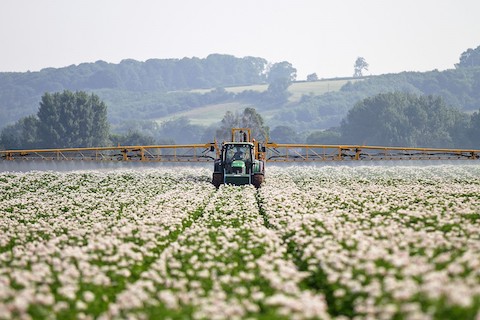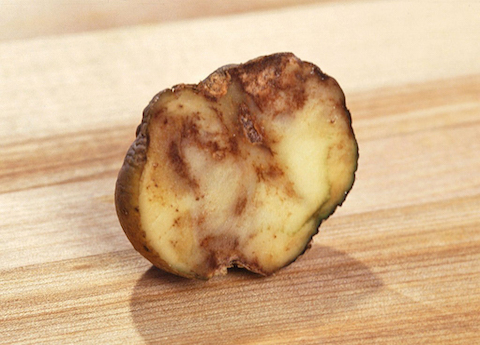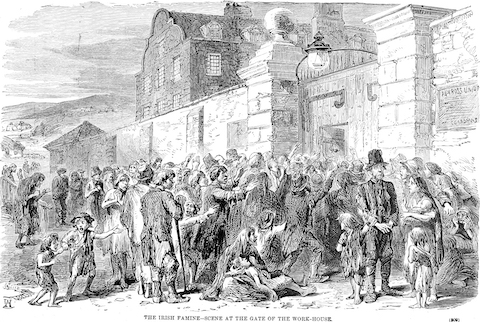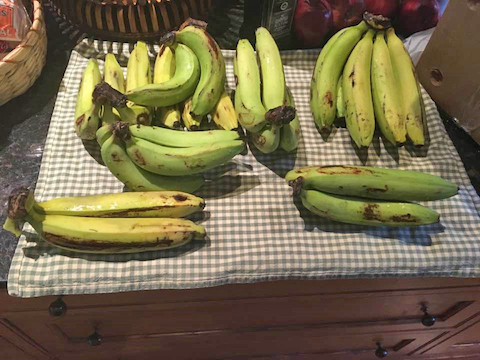
Credit: Chafer Machinery, via Wikimedia Commons
This story is bananas. But it begins with potatoes.
In the mid-1800s, Ireland depended largely on potatoes. The crop was all one species, called the Irish Lumper, grown easily by propagating new plants from old potatoes.
It was monoculture in its strictest form: the new plants were genetically identical to the old ones …
Which allowed a potato fungus to sweep across the country, devastating Ireland’s potato crop for years afterward.
A million Irish died of starvation. Two million left the country.
A hundred years later, it happened again. But this time to bananas.
The world’s banana crop was also a monoculture, grown through propagation. In the 1950s, it was all one species called Gros Michel.
When a fungus attacked, it wiped out the entire crop – in fact, it made the Gros Michel banana virtually extinct.
Growers scrambled to find a disease-resistant species, and did so in China, called the Cavendish. Now that’s our only global strain of bananas.
In Colombian plantations, a new pathogen is preying on the Cavendish. As farmers try to keep it from spreading, scientists are using modern agricultural technology to develop new resistant strains.
The moral of this bananas story? Monoculture may be efficient, and it simplifies farming. But biodiversity produces a stronger and more resilient crop.
Background
Synopsis: In the mid-1800s, a fungal blight infested potato farms in Ireland, causing more than half of the crops to succumb for seven years. Thirty percent of the Irish population starved or emigrated that decade, and the Irish population has still not recovered to prefamine levels. In the late 1950s, a fungal blight wiped out the most popular banana of the time. Growers could only find a single disease-resistant Chinese variety that we still consume, but that variety is just as vulnerable today as the 1950s variety was then—today the Chinese variety is under threat from a more virulent pathogen. What would life be like without bananas? These are extreme examples of the risks of monoculture, a practice that makes farming more efficient but makes crops more vulnerable to catastrophic loss.
- Ireland’s Great Famine of 1845 to 1849 is an extreme example of a monocultural disaster.
- In the 1800s, Ireland was governed as a colony of Great Britain, and Irish Catholics were prohibited from owning or leasing land, holding office, or voting until the 1830s. But by then, they could only work as tenant farmers.
- Because British tariffs made grains and corn prohibitively expensive, the Irish working-class diet in the mid-1800s was almost completely based on a specific variety of potatoes known as the Irish Lumper.
- Potatoes were originally domesticated in Peru and Bolivia more than 7,000 years ago and made their way to Europe in the 16th century.
- Lumpers were propagated vegetatively by cutting a potato into pieces, each piece including an “eye,” and planting the pieces in soil. Each potato that grows from a cutting is genetically identical to the original potato. This lack of diversity increases crop vulnerability to pests and pathogens.
- In 1845 a fungus-like organism called Phytophthora infestans arrived in Ireland from the Americas (probably from Mexico), spreading rapidly and ruining half of the potato crop that year and three-quarters of the crop over the next seven years.
- By 1852, more than a million Irishmen had died of starvation and malnutrition-related causes, accounting for one-eighth of the country’s population.
- By 1855, more than 2 million had left the country as refugees, heading to Canada, the United States and Australia.
- The country’s 2022 population of about 7 million has not yet reached the prefamine population of 8.2 million.

Credit: USDA
- In the 1950s, consumers in the United States enjoyed an easy-to-ship and tasty variety of bananas with small seeds called the “Gros Michel” banana.
- Because of their more appetizing small seeds, all these bananas had to be propagated using cut suckers from existing plants, rendering them genetically identical.
- In the 1960s, a fungal pathogen known as Fusarium wilt spread throughout the soils of Caribbean plantations, infecting Gros Michel trees and slowing vascular flow, causing the plants to wilt and die.
- The song “Yes! We have no bananas” was popularized as the American public pondered a future without bananas.
- Farmers searched for a solution and located just one other similar and disease-resistant Chinese variety, known as the Cavendish.
- The Cavendish was not quite as tasty as the Gros Michel and bruised more easily during shipping, but it was easy to harvest and had small seeds.
- As the Gros Michel variety was ravaged, the Cavendish gradually replaced it in global markets.
- Every person on earth consumes nearly three Cavendish bananas per week—more than 130 bananas in a year. All these bananas are genetically identical.
- Like the Gros Michel, the Cavendish’s small seeds require it to be propagated by cut-sucker cloning, so experts have long acknowledged that the monoclonal Cavendish banana is at risk from another blight.
- Sure enough, a more virulent pathogen has recently been detected on Cavendish banana plantations in Colombia.
- New strains that are resistant to the pathogen, tasty and easy to ship are in the process of being developed, but reshaping the global banana infrastructure may take 15 to 20 years.

Credit: Internet Archive Book Images, via Wikimedia Commons
- Monoculture is an agricultural practice that simplifies farming but has its risks.
- The practice of growing a single crop or rearing a single breed of livestock at a time is known as monoculture.
- Monoculture increases efficiency and yields, making it easier for farmers to plant, irrigate, fertilize, and harvest their specific crops. However, the lack of genetic diversity makes monocultural crops more vulnerable to catastrophic microbial blight and pest infestations.
- Monocropping repeated year after year in the same space can degrade the soil by reducing nutrients and decreasing beneficial microbe and insect diversity.
- Monocropping may lead to topsoil erosion, a decrease in soil water retention and water-supply strain by requiring increased irrigation.
- Industrial-scale monoculture employs special technologies to monitor crop health and development but also tends to use large amounts of artificial herbicides, insecticides, bactericides, and fertilizers that end up in the food chain, polluting surface-water and groundwater resources.
- Putting all the eggs in one basket, livestock monoculture has similar risks.

Credit: Zwifree, via Wikimedia Commons
- Reducing the intensity in time or in space of monocultural crops (crop rotation) and using specialized technologies (crop monitoring and targeted application of fertilizers, pesticides, and herbicides) may mitigate some of the risks of monocultural practices.
- Biodiversity is a natural way to diminish the risks of monoculture.

